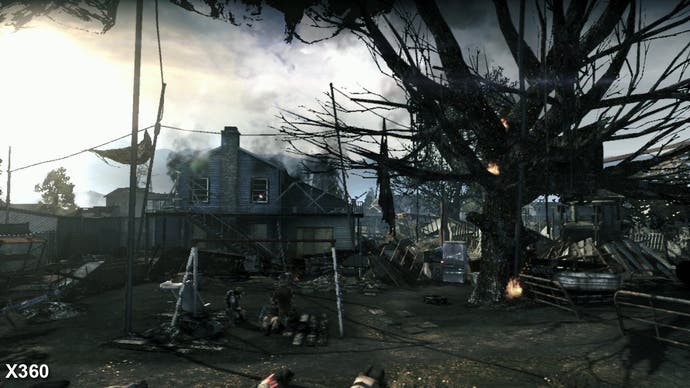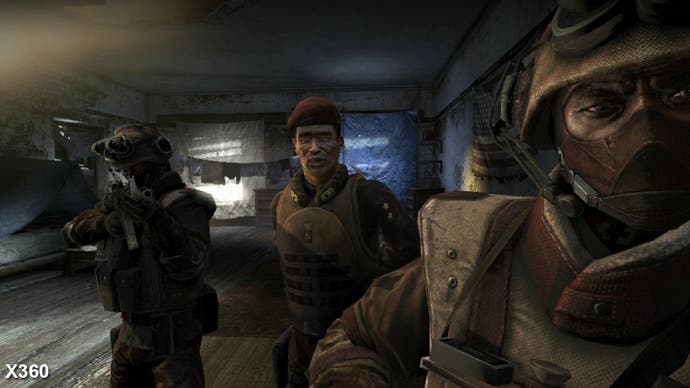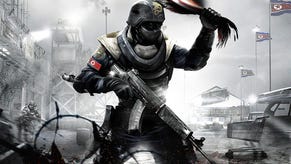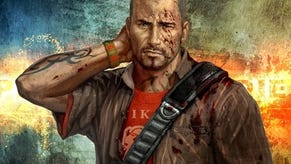Face-Off: Homefront
Korea advice.
| Xbox 360 | PlayStation 3 | |
|---|---|---|
| Disc Size | 6.0GB | 6.4GB |
| Install | 6.0GB | 2048MB |
| Surround Support | Dolby Digital | Dolby Digital, DTS, 5.1LPCM, 7.1LPCM |
The stakes have never been higher for games publishers and developers looking to break into a first-person shooter market dominated by Call of Duty, Halo and Battlefield. In just the last few weeks we've seen the likes of Sony and Epic try their luck, releasing two superb, well-received titles in the form of Killzone 3 and Bulletstorm that have failed to make a substantial impact on the charts despite prodigious development and marketing budgets.
This week it's squeaky bum time for THQ as Homefront launched to a range of mixed reviews, with Eurogamer awarding the title an above average 6/10. While multiplayer offered fresh new game modes and 32-player support (even on console), it seems that the weakness of the single-player campaign combined with its brevity has seen scores for the overall package come in lower than expected.
Technology plays a crucial part in the make-up of a first-person shooter. As we discussed recently in our Medal of Honor Face-Off, the heavy hitters in the genre tie the core experience to unique elements in their technological arsenal: Call of Duty relies heavily on its 60Hz precision response, for example, while Battlefield's Frostbite engine offers a currently unparalleled physics and destruction model combined with state-of-the-art visuals and expansive play areas.
Homefront is intriguing in that a lot of the investment has gone into setting up dedicated servers for all platforms, meaning that its greatest innovations are reserved for multiplayer only. So the technological edge is in the infrastructure and how this allows for a larger, more expansive range of gameplay possibilities. Unfortunately, it does seem that client-side Kaos appears to be lagging behind its competitors, and despite some impressive HDR lighting tech, the game struggles to exceed the visuals standards we've seen elsewhere. In this sense, in terms of both tech and art, Homefront comes up short.
Here's how the game looks on Xbox 360 and PlayStation 3, and in addition we also have a Homefront triple-format comparison gallery, adding the PC version to the mix.
Homefront is running on Unreal Engine 3, but it's fair to say that Kaos' extensive modifications to Epic's tech make this look quite unlike any UE3 title we've looked at to date. Probably the most noteworthy change to the overall presentation compared to other titles running on the engine is in the lighting: Homefront's HDR-style effects are often impressive, adding mood and atmosphere to the environments and an increased sensation of depth in the night-time scenes. The other key innovation we see is in the multiplayer mode - the sheer real estate in the maps is quite extraordinary. Think MAG rather than Black Ops.
However, it seems that the implementation of these features comes at a significant cost - Homefront runs at a reduced native resolution of 1024x576 on both console platforms, and while the Xbox 360 version of the game features 2x multi-sampling anti-aliasing to smooth off the edges, the PS3 version has none at all, emphasising the upscaled jaggies.


It's rare that we come across a UE3-based title that isn't running at full 720p (if memory serves, Mortal Kombat vs. DC Universe was the last, and that was a necessity of its 60Hz update) and while the lighting does differentiate itself from the competition in terms of the game's overall look and feel, the resolution drop is a big hit. Kaos isn't alone in modifying Unreal Engine 3's basic lighting systems: EA's Danger Close studio managed to implement a full light pre-pass deferred rendering solution for Medal of Honor. But it still maintained a smooth frame-rate and full 720p resolution.
Performance analysis of both console versions of Homefront throws up some very weird stats. A basic given of Unreal Engine 3-based titles is that in most cases we see a target frame-rate of 30FPS, with v-sync dropped in stressful situations. Screen tear kicks in, but at least the gameplay remains fluid and as responsive as possible.
This state of affairs only seems to apply to the PlayStation 3 version of Homefront, with Kaos coming up with another solution for the Xbox 360 - namely, running the game with an uncapped frame-rate. The results are not so impressive. Homefront tears really, really badly on the Xbox 360 and while the player is getting more visual feedback from the game (control feels a touch smoother compared to the PS3 version), the impact to the image consistency is very significant indeed and definitely detrimental to the overall quality of the game.
Based on performance alone, while the Xbox 360 version of Homefront offers higher frame-rates, the PS3 game could be considered the more consistent performer, and with the tearing significantly reduced (though still difficult to miss), that should make the decision of which version to buy very straightforward. Except things aren't so cut and dried, because there are some significant technical differences elsewhere.
First up, texture streaming. This particular weakness of the Unreal Engine 3 tech came to the fore in Mass Effect, where the sudden appearance of detailed art over ultra-low res placeholders had a profound impact on the look of the game. Epic addressed this with blended mip-mapping in Gears of War 2, an enhancement that sees the different quality assets merge, producing a much smoother look. Unfortunately, we don't see much of this in Homefront, where assets regularly stream in and pop up - something especially noticeable on Xbox 360 (even with a hard drive install) but still a factor on PlayStation 3.
The second major difference in the two console versions concerns the lighting model that divorces this game from a great many of its UE3-based competitors. Things are definitely brighter on PS3, but this doesn't seem to be down to any kind of artistic choice - it's more likely that occluding lights are turned off on the Sony platform, meaning that more subtle nuances in the lighting simply aren't being rendered, making the overall game look a bit more basic in comparison. In this respect, the PC version is a match for the 360 game.







